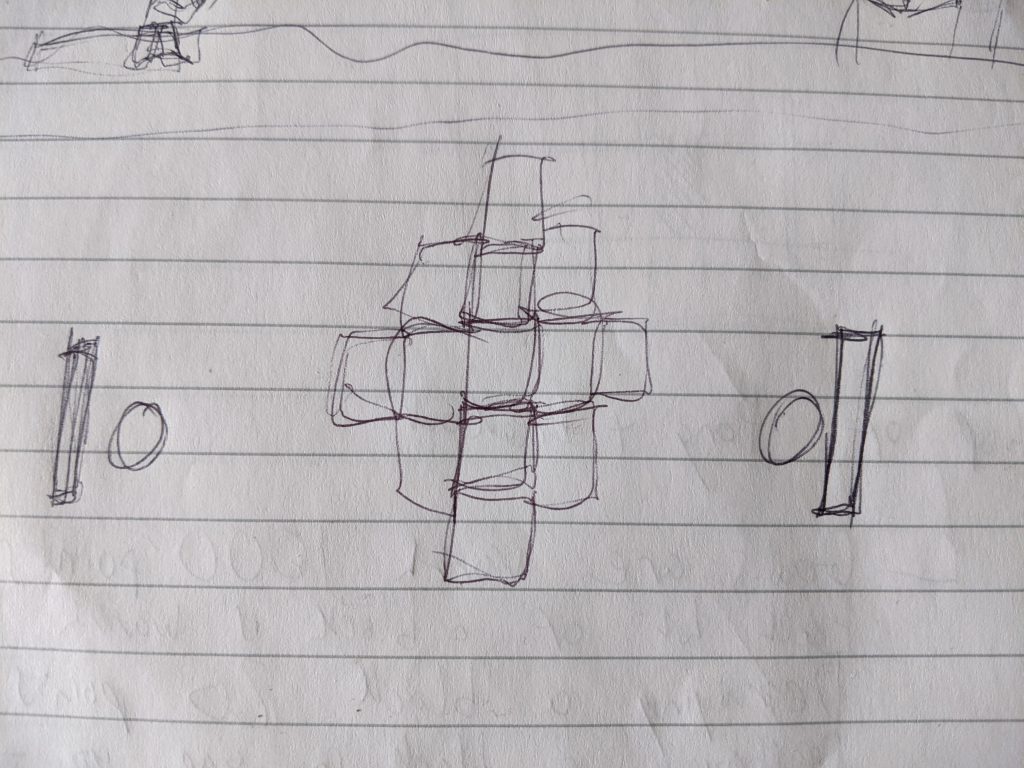To develop my idea, I sketched out a very basic idea for how it would look.

Essentially the player would need to break through blocks to accumulate points and then once they had broken a big enough space, they would score goals.
This game idea in and of itself would not be that interesting alone and of course gaming has come a very long way since the days of Pong and Breakout, so I decided to brainstorm some ideas for enhancements for how I could increase the excitement of the game.
Some of the ideas I came up with are as follows:
- Make the blocks harder to destroy, i.e. they require multiple hits to destroy
- The balls change colour every few seconds, if the colour of the ball and the colour of the block matches, they automatically destroy
- Moving blocks
- Blocks which respawn after a period of several seconds, prolonging gameplay
- Use of power-ups to make the game more challenging
- Increased speed
- Multiple paddles
- Wider paddles
- Multiple balls
- Lasers or other such weapons to destroy your opponent
- Exploding blocks
- A time limit on the game or a maximum score to reach
- Make the game in 3D
- The game can be multiplayer or playing against an AI
- Your opponent becomes weaker / slower with the more goals you score
These are ideas that I came up with, but I am probably unable to use all of them in my game given the time that I have to make it, so I used another ideation technique called a mind map, in order to organise these ideas in terms of how they relate to one another, but also to assess how feasible they are to do and to consider what I will need to learn in order to develop each aspect of this project.
Mind mapping differentiates from Alex Osborn’s brainstorming model as it is less about the spontaneous generation of ideas, but more about idea generation by association; that is ideas based on other ideas (Luenendonk, M., 2019). Mind mapping also puts a greater emphasis on visualisation, which means that I can organise this in a way that is meaningful and so that I can work out how component relates to each other. I will also use a mind map to work out what assets are required and how they are related.
I produced the mind map using a piece of software called MindView. To view it more clearly, please click the below image and it will open as a PDF… or just click here.
I produced a mind map with my ‘Pong / Breakout game’ as the central topic and from that I came up with three distinct branches:
- Concept: I used this to branch to gain more understanding of the concept of the game, as well as how it relates to the original source material. This helped me to gain an understanding of the basic mechanics, particularly the mechanics that Pong and Breakout have in common (both have paddles and a ball), as well as how they deviate from one another’s mechanics (one involves scoring a point in the opponent’s area, the other involves breaking blocks).
- Gameplay: This is where I worked out all of the gameplay of my game, such as the object of the game, how the player scores points, what the power-ups represent, etc.
- Assets: Once I had worked out the gameplay, I got onto brainstorming assets that I would need to produce my game. This stage allowed me to reflect on the skills that I already possess that would be required to realise this project, but also to work out what I need to learn to produce these assets.
MindView was useful for aiding me in visualising what I will need for this project. Having visualised my entire idea, I realise that it will be fairly complex as there are a lot of assets that tie into one another and there are a lot of loose ends I will need to tie quickly.
This mind map also functions much like a Game Development Document which is often a lengthy document which describes each part of the game process (Rogers, S., 2014). As my concept is based on a simple premise, I am able to use my mind map much like a GDD, but it also helped me to visualise my requirements.
As I build my game, I will gain more of an understanding of what it means to fail quickly so that I can learn and progress quickly. As I progress, I will continue to reflect on how my previous research into learning and ideation methods have informed the outcome of this game.
References
Luenendonk, M., 2019. Techniques for Idea Generation: Mind Maps. [online] Cleverism. Available at: <https://www.cleverism.com/techniques-idea-generation-mind-maps/> [Accessed 5 February 2021].
Rogers, S., 2014. Level Up! The Guide to Great Video Game Design, 2nd Edition. 2nd ed. Chichester: WIley, pp.65-68, 85-92.


“This mind map also functions much like a Game Development Document which is often a lengthy document which describes each part of the game process.”
Exactly what we used to do. From the initial mind-mapping we would build a GDD around it. Formalising it into a larger document always helped find the “holes” in the design, and helped to form a better understanding of the game concept as a whole.
Even for a small game it is worthwhile doing, in my opinion.
Thanks Francis. Yes definitely a lot to be said for building a GDD and making it as visual as possible. This has really helped me to work out what I will need to build this.